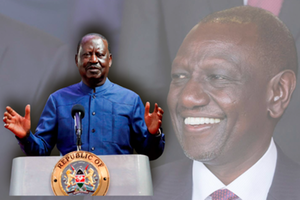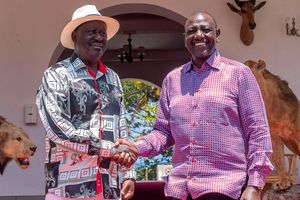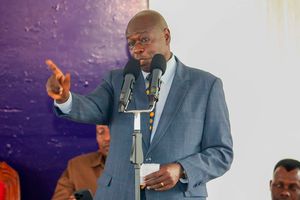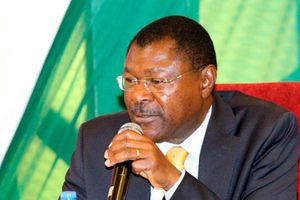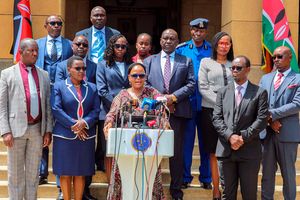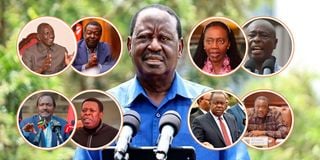
Political heavyweights, including President William Ruto, Uhuru Kenyatta and Raila Odinga are playing a high-stakes game of coalition building.
A notice by the Office of the Registrar of Political Parties (ORPP) has lifted the lid on the shifting political alliances as outfits begin to exit pre-election pacts signed in the run up to the 2022 General Elections.
Several political parties that signed for pre-election agreements have since exited their coalitions while others are in the process of formalising their divorce.
Based on the shifting alliances, Kenya Kwanza remains the Majority coalition in the National Assembly with 165 members while Azimio la Umoja is the Minority with 154 members.
The High Court had declared the opposition coalition as the Majority, a position National Assembly Speaker Moses Wetang’ula overturned, citing post-election realignments.
In Azimio la Umoja One Kenya Coalition of opposition leader Raila Odinga, five parties have since formally exited, with two others also in the process of leaving.
People’s Liberation Party – formerly Narc Kenya – of Ms Martha Karua, who was Mr Odinga’s running mate, is one of the outfits who have formally exited.

Former Deputy President Rigathi Gachagua when he visited Narc Kenya leader Martha Karua at her home in Kimunye village, Kirinyaga County on January 25, 2025.
Others are United Democratic Movement (UDM) of Mandera Senator Ali Roba, Pamoja Alliance (PAA) of Senate Speaker Amason Kingi, Devolution of Empowerment Party of former Meru Governor Kiraitu Murungi and Mandeleo Chap Chap of Labour Cabinet Secretary Alfred Mutua.
Registrar of Political Parties Anne Nderitu has also revealed that Movement for Democracy and Growth (MDG) of Ugenya MP David Ochieng’ had also issued a notice to exit Azimio. MDG is yet to conclude the exit process.
Democratic Action Party of Kenya (DAP-K) of Eugene Wamalwa has also indicated its plans to exit. The party, however, appears not to have initiated the formal process.
The development leaves the political juggernaut that was designed to propel Mr Odinga to State House with a total of 21 political parties, among them Orange Democratic Movement (ODM) of the former Prime Minister, Jubilee Party of former President Uhuru Kenyatta, Wiper of Mr Kalonzo Musyoka, independence party Kanu among others.
Jubilee Secretary General Jeremiah Kioni described the notice as mischievous and only meant to sanitize National Assembly's Speaker Moses Wetang'ula's decision to overturn the High Court ruling that declared Azimio as the majority coalition.
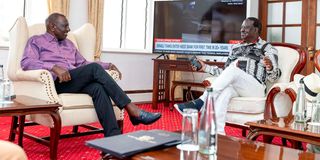
President William Ruto and former Prime Minister Raila Odinga at State House in Mombasa on February 24, 2025.
"ORPP appears not to be independent. This is why we are pushing for having ORPP turned into a commission so that decisions are not made by an individual," said Mr Kioni.
In Kenya Kwanza, Amani National Congress (ANC) associated with Prime Cabinet Secretary Musalia Mudavadi has since filed for dissolution to join President William Ruto’s United Democratic Alliance (UDA).
Dr Ruto abandoned the much-hyped merger between his UDA and ANC over fears of mass defections, especially by Mt Kenya elected leaders.
A clause guiding mergers of political parties provides for defection of members, who are dissatisfied with such a deal.
Section 11 of the Political Parties Act that spells out conditions for merger provides that elected leaders – who are against such a merger – are at liberty to defect to other political parties or become independent.
“Where a party merges under this section, a member of the political party that has merged with another political party shall be deemed to be a member of the new political party,” states subsection 7 of the Act.
“Despite subsection (7), a member who is a President, Deputy President, Governor or Deputy Governor, Member of Parliament or member of a County Assembly, and who does not desire to be a member of the new political party registered after the merger shall continue to serve in such elected office for the remainder of the term, and may join another political party or choose to be an independent member within thirty days of the registration of the new party,” the Act provides.
Ms Nderitu noted that her office was in the process of concluding the dissolution of ANC.
“The Amani National Congress has filed a notice of dissolution and other relevant documents. The Registrar is processing the dissolution,” stated the notice on status of political parties in coalitions.
According to the notice, a total of 11 political parties signed a pre-election agreement in forming the Kenya Kwanza alliance.
The parties include UDA, ANC, Forum for Restoration of Democracy – Kenya of National Assembly Speaker Moses Wetang’ula, Chama Cha Kazi of former Cabinet Secretary Moses Kuria, Economic Freedom Party (EFP) of Issack Abey among others.
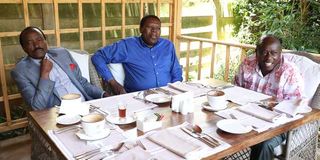
Wiper Party leader Kalonzo Musyoka (left), his DAP-Kenya counterpart Eugene Wamalwa, and former Deputy President Rigathi Gachagua when they met at Karen Blixen in Nairobi.
Mr Abey told Nation that his party was contemplating exiting Kenya Kwanza alliance for being ignored despite campaigning for President Ruto.
Four additional parties signed a post-election agreement to join the ruling alliance. They include Democratic Party of Kenya associated with Public Service CS Justin Muturi, National Agenda Party of Kenya, Chama Cha Mashinani and Grand Dream Development Party.
The country currently has a total of 92 fully registered parties. According to ORPP, a total of 47 parties have no representation in parliament. The billions of shillings for political parties has made running a political party a lucrative business.
Dozens of parties that have never benefited from millions of shillings disbursed by the exchequer have for the first time after the 2022 elections received the monies, making running of political parties a lucrative business. This was after the changes to the Political Parties Act.
The Act provides that 70 per cent of the money be distributed proportionately, based on the total number of votes secured by a political party in the preceding election.
Another 15 per cent is to be distributed proportionately to parties based on the number of candidates from special interest groups elected in the preceding General Election.
Ten per cent shall be shared out proportionately to parties, based on the number of representatives from the party elected in the preceding General Election while the remaining five per cent is for administration expenses by the ORPP.
The provision implies that any political party that participates in a General Election stands to benefit from the funds, based on the number of votes attributed to its candidates, even if a majority of them lose at the ballot.

